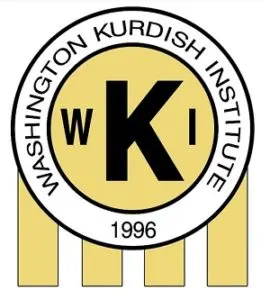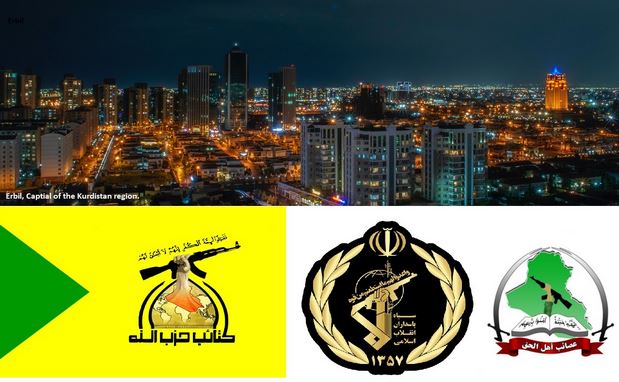Washington Kurdish Institute
July 12, 2021
On Tuesday July 6, and for the fourth time, Iranian-backed militias attacked Erbil international airport in the capital of the Kurdistan region of Iraq by “suicide drone.” Since December 2020, Iranian-Iraqi proxies have launched four attacks on Erbil, targeting the airport and areas hosting a symbolic number of US troops, part of the global coalition to defeat ISIS (Da’esh). Simultaneously, tens of similar terrorist offensives have targeted US bases, embassy, and logistical convoys.
Who are these attackers?
Radical Shia groups exist within the Popular Mobilization Units (PMU), an official Iraqi force formed to fight Da’esh in 2014. The PMU also includes a small number of Sunnis and Christians. The Iranian Revolutionary Guards Corps (IRGC) played an essential role in training, equipping, and even financing these groups in the early stages. By 2018, Iraq’s Shia majority government passed a law making these militias a parallel force of Iraq’s military. Iran’s historical influence over the Iraqi Shia parties has paved the way for the PMU to become more powerful and what they are today: outlaws and uncontrollable militants.
Iran aimed at and succeeded in making the PMUs similar to the IRGC, a force linked directly to the Supreme Leader and a “protector” of the Islamic regime, formed in 1979. Since the foundation of the IRGC, the Iranian Army (Artash) has become a secondary force.
The PMU is divided into hundreds of brigades with tens of different loyalties to Shia parties, clerics, politicians, and explicit loyalty to Iran’s regime. Among those, the infamous Asa’ib Ahl al-Haq and Kata’ib Hezbollah, each have shadow militias responsible for attacks.
What have they done?
Soon after Da’esh declared the “Caliphate” and controlled a large swath of Iraqi territory, the Shia Marja’ Ali Sistani released an Islamic ruling known as (Fatwa) encouraging Iraqis to fight the terrorist group. Iran soon joined the fight and overtly but informally sponsored the training and the organization of the PMUs. Iran’s readiness to fight Da’esh came months before the US formed the global coalition, contributing to a more robust security grip in the country over the US.
Indeed, Iran enjoyed loyalty from the Shia population, making it easier to direct these militias to agendas beyond the fight against Da’esh. At the same time, the US launched its war on ISIS by rebuilding the dissolved Iraqi army after Da’esh killed thousands of its members and seized US-made weapons given to Iraqis.
The PMUs suffered significant casualties from Da’esh but were able to take advantage of the US strikes and coordinate their expansion in the shadows since the global coalition rejected direct communications with the PMU. For decades, Iran had proxies in the region, but many factions within the PMU became official Iraqi proxies, defecting even from fellow Shias loyal to Sistani. Moreover, Iran soon used the PMUs to implement its expansion and regional influence, linking Syrian and Iraqi proxies known as Iran’s “Land Bridge”.
Since the physical defeat of Da’esh, the Iranian-backed militias have remained in the Sunni region, in complete control of its security, or at least semi-control in some areas, challenging the Iraqi security forces. The Sunni region suffered atrocities perpetrated by these militias, including mass killings and displacements. Furthermore, to change the demographics of the towns, the Iranian-backed militias prevented the return of the displaced Sunni families, especially in mixed Sunni and Shia areas, allowing loyal Shias to dominate local governing bodies. Those areas included parts of Diyala and Saladin provinces.
What do these militias control and target?
Since December 9, 2017, when Iraq declared “victory” over the Da’esh “Caliphate,” the presence of the Iranian militia stretched from eastern Diyala province on the Iran-Iraq border to the Syria-Iraq border in western Anbar province. The region consists of Sunni areas, Kurdish areas disputed by Baghdad, the Nineveh Plains of Christians, and a minority Shia population. Since 2017, Iran and the PMU have also recruited a small number of Sunni tribal members and some Christians and Yazidi Kurds. The PMUs also attempted to recruit Kurds in Kirkuk but failed after a strong Kurdish rejection.
In each city center and town, the PMUs, especially the Iranian-backed factions, operate separately from the Iraqi military. For example, in the Yazidi area, mainly Shingal (Sinjar), the militias have prevented the implementation of a security agreement between Baghdad and Erbil. Further, in Kirkuk, the PMU has several bases and has opened a training center inside a strategic military base called K1. None of these militia groups is coordinating with the Iraqi military. The same situation exists across liberated areas like the Nineveh plains, Khanaqin, Tuz Khurmatu, Ramadi, etc. These Shia militias killed hundreds of anti-government protesters that were demanding reforms in the fall of 2019.
Why attack the US, Baghdad, and Erbil?
The late Iranian general Qasim Soleimani played a leading role in forming and managing the PMU and recruiting many factions to become Iran’s proxy. Indeed, the Iraq militia leader Abu Mahdi al-Muhandis helped Soleimani, as he had had ties with the IRGC and Iran for more than four decades. al-Muhandis was accompanying Soleimani when the US struck their convoy, killing both men.
Soleimani’s death marked a new era between the US and Iran. First, Soleimani had plans to intensify attacks against the US in Iraq as Iran came under immense economic pressure from the former administration. Second, the Iranian regime, mainly the hardliners and the IRGC, wanted to end the US presence in Iraq and control what was left in the country, especially after the fight against Da’esh became a secondary subject and the focus shifted to better governance. The first official escalation against the US started in Kirkuk when militants targeted several US service members.
Kirkuk and the rest of the “disputed territories” between Baghdad and Erbil have come under the de facto control of Iran. This situation goes back to wrongheaded policies of the US under President Trump dating from October 16, 2017. For example, the US should have never allowed Iranian-backed militias and the Iraqi government led by Prime Minister Abadi to attack Kurds and control strategic areas in the country once run by Kurds, only US partners in Iraq. Iraq used the independence referendum held by the Kurds in 2017 as a pretext to restore its longstanding discriminatory policies against the Kurds. Soon after the October 16, 2017, war on the Kurds, the US was obliged to leave the area and lost much of its national security interest. Today, the militants use the disputed territories for drug trafficking and oil smuggling, a primary income source.
Iran is hitting many targets with few proxies
First, attacking Americans in the Kurdistan region undermines the security and friendly environment the area has enjoyed for decades, attracting western investment and international backing. The Kurds have been welcoming US partners since 1991, but this will affect the image of Kurdistan and impose an existential threat. Even the notion of a “safe Kurdistan” will no longer be the case for the US and other countries to consider.
Second, Iran wants to further aggravate the issues between Erbil and Baghdad. By hitting Erbil, the tensions between the Peshmerga forces and Iraqi military will increase, since the attacks against Erbil are launched from areas under Iraqi military control and that have no power over these militants. At the same time, the Iraqi government has prevented returning Kurdish forces from operating jointly in the disputed areas.
Third, Iran hoped for a softer approach from the US and a faster reintegration with the Joint Comprehensive Plan of Action (JCPOA), known as the Iran Deal under the Biden administration. But the US learned lessons from its previous version of the agreement, where Iran exploited the deal and built a proxy empire across the region. Hitting the US in Iraq might put pressure on talks between the US administration and its European mediators to reach a deal faster, hoping it will stop the Iranian aggression in Iraq and Iran.
Fourth, Iran, since May 2020, has used its proxies and militias to undermine the US-backed Iraqi government led by Mustafa al Kadhimi. Nonetheless, Shia parties have been unable to install a pro-Iran prime minister like previous ones, mainly due to widespread anti-government protests blaming Iranian-Iraqi proxy politicians of mismanagement since 2003.
All of the above reasons result in Iran’s win-win status. Another broader sense is that after 2003, Iran worked in various ways to destabilize Iraq, including by directing hatred against the Kurds. For example, Iran supported all sides of the conflict in Iraq under the rule of “divide and conquer.”
The three sides can challenge Iran and its proxies
On the opposite side of Iran and its militias are Washington, Baghdad, and Erbil. These main sides could challenge Iran and decrease the threats and terror attacks by these groups but are far from doing it due to ill-advised policies regarding the Kurds.
First, Baghdad, since 2014, has continued to impose economic pressure on the Kurdistan region by cutting its federal budget and withholding employee salaries. For example, after months of meetings and dialogue backed by the US, the Iraqi parliament passed the 2021 budget law, mandating the release of employee salaries. Still, months after its passage, the law has not been implemented. Furthermore, Baghdad also did not hesitate to ally itself with Iranian-backed militias and Iran to attack the Kurds in 2017, when militants displaced thousands of Kurds and burned many Kurdish homes. To this day, the disputed territories remain unstable and Kurds are suffering from Arabization policies.
Second, the US chose Baghdad over Erbil during the independence referendum held by the Kurds, leaving the Kurds to become a meal for Iran. To this day, the US’s Kurdish policy remains biased toward Baghdad, despite Baghdad’s repeated anti-US stances.
Third, Baghdad undermined the Kurdistan region by letting Turkey occupy the northern side of the region under the pretext of fighting the Kurdistan Workers’ Party (PKK). Frequently, Iraq calls for the restoration of “sovereignty,” – except when it comes to Kurdish land.
Until the above issues are resolved, Iran and its proxies will continue to grow and have a more robust presence in Iraq, despite a significant loss of public support due to their criminal acts.

